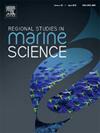Comparative study of magnetic properties of sediments from six monsoonal rivers during the wet and dry periods, west coast of India
IF 2.1
4区 环境科学与生态学
Q3 ECOLOGY
引用次数: 0
Abstract
Environmental magnetism, in combination with Scanning electron microscopy (SEM) and X-ray diffraction (XRD), was carried out on the surface sediments of six rivers from the Goa and Karnataka regions (India). The main focus was determining the magnetic properties of sediments from different depositional environments (marine, estuarine and fluvial) and assessing their variation with the provenance. In addition, various factors (catchment rocks, anthropogenic activities, river morphology) that influenced the magnetic signatures were explored. Most rivers showed higher magnetic concentrations in the wet period compared to the dry period. The magnetic concentrations (χlf) in the Goa rivers (Terekhol, Chapora, Sal, Talpona) were 6–10 times higher than that of the Karnataka rivers (Nethravati and Gurupur) and displayed a systematic decrease from the river towards the estuary mouth/sea reflecting hydrodynamic sorting. In the Karnataka rivers, on the other hand, irregular χlf profiles were attributed to factors such as dredging, river geomorphology, abundant quartz minerals and variations in Estuarine Turbidity Maxima’s locations. Based on magnetic parameters and elemental composition obtained from SEM-EDS analysis and confirmed by XRD results, magnetite was identified as the main magnetic mineral in the Goa rivers, while a mix between magnetite and hematite was proposed in the Karnataka rivers. Anthropogenic activities (sand mining) and local geological background contributed to magnetic enhancement in the Goa rivers, while river morphology (meandering) and hydrodynamic processes controlled the magnetic properties in the Karnataka rivers. The negative correlations between χlf and finer sediment fraction, as opposed to other global studies, suggested the possibility of such occurrence in similar systems worldwide. The biplot between magnetic grain size and χlf in the Karnataka rivers could fingerprint the source and track the environmental changes. Thus, the magnetic measurements were helpful in the discrimination and identification of different depositional environments.
求助全文
约1分钟内获得全文
求助全文
来源期刊

Regional Studies in Marine Science
Agricultural and Biological Sciences-Ecology, Evolution, Behavior and Systematics
CiteScore
3.90
自引率
4.80%
发文量
336
审稿时长
69 days
期刊介绍:
REGIONAL STUDIES IN MARINE SCIENCE will publish scientifically sound papers on regional aspects of maritime and marine resources in estuaries, coastal zones, continental shelf, the seas and oceans.
 求助内容:
求助内容: 应助结果提醒方式:
应助结果提醒方式:


